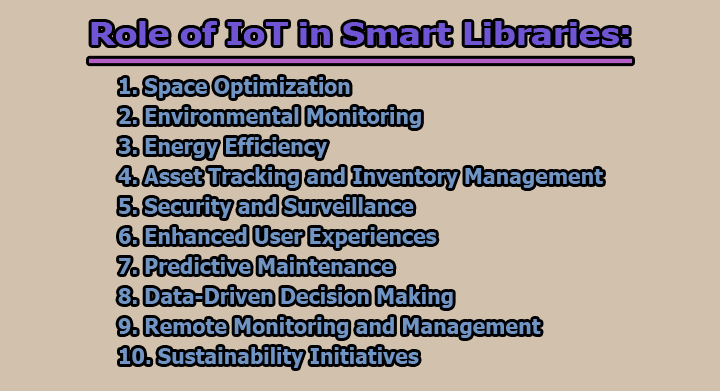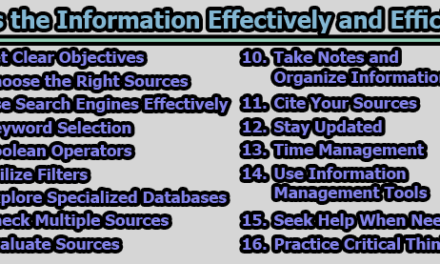Role of IoT in Smart Libraries:
In the fast-evolving digital landscape, libraries are embracing the transformative power of the Internet of Things (IoT) to redefine their role as dynamic and responsive spaces. IoT technology is revolutionizing smart libraries, enhancing operational efficiency, user experiences, and sustainability practices. In the rest of this article, we will explore the multifaceted role of IoT in smart libraries.
1. Space Optimization: Smart libraries are leveraging IoT sensors strategically placed throughout their facilities to monitor real-time occupancy levels. This granular data empowers libraries to dynamically optimize space utilization. By identifying underutilized areas that can be repurposed or areas requiring additional resources, libraries can adapt their layouts to meet the evolving needs of patrons. This not only enhances operational efficiency but also ensures that library spaces are responsive to the ever-changing demands of the community, ultimately improving the overall user experience.
2. Environmental Monitoring: The preservation of valuable and often sensitive materials is a paramount concern for libraries. Here, IoT devices, particularly environmental sensors, play a pivotal role. These sensors monitor crucial environmental conditions such as temperature, humidity, and air quality in real-time. By proactively managing these parameters, libraries can ensure the optimal preservation of materials, reducing the risk of damage or degradation. Furthermore, this approach contributes to energy conservation by fine-tuning environmental controls, creating a comfortable atmosphere for patrons while minimizing the library’s ecological footprint.
3. Energy Efficiency: The quest for sustainability in libraries is significantly aided by IoT technology’s ability to optimize energy consumption. Real-time monitoring through smart sensors and meters provides libraries with insights into their energy usage patterns. For example, smart lighting systems adjust illumination levels based on occupancy and natural light availability, effectively minimizing energy waste without compromising visibility or safety. Similarly, IoT-enabled Heating, Ventilation, and Air Conditioning (HVAC) systems intelligently adjust temperature and ventilation settings based on occupancy and environmental conditions, ensuring patron comfort while maximizing energy efficiency.
4. Asset Tracking and Inventory Management: RFID technology, an integral component of the IoT ecosystem, is transforming asset tracking and inventory management in smart libraries. By embedding RFID tags in library materials, these institutions can achieve quick and accurate identification and tracking of items throughout their systems. This innovation streamlines labor-intensive processes such as shelving, inventory audits, and locating misplaced items. Furthermore, RFID technology supports self-service checkout systems, providing patrons with a seamless and efficient borrowing experience, reducing reliance on staff intervention.
5. Security and Surveillance: The safety and security of library facilities are paramount concerns, and IoT-enabled security systems address these challenges with sophistication. Sensors and cameras deployed strategically throughout the library continuously monitor access points, detecting unauthorized entry and potential security threats. Real-time alerts empower library staff to respond promptly to incidents, ensuring the safety of patrons, staff, and valuable assets. By leveraging IoT for security and surveillance, libraries create a secure and welcoming environment, fostering a sense of trust within their communities.
6. Enhanced User Experiences: The overarching impact of IoT in smart libraries is the enhancement of user experiences. By providing seamless access to resources, optimizing the physical environment, and ensuring safety and security, IoT devices contribute to creating dynamic and responsive spaces. Patrons experience a library that adapts to their needs, offering a personalized and efficient journey. For instance, real-time data on space utilization allows libraries to rearrange seating or allocate resources based on demand, ensuring that users can navigate the library space with ease and find the materials they seek. This enhanced user experience fosters a positive perception of the library as a modern, accessible, and user-centric institution.
7. Predictive Maintenance: Predictive maintenance is a game-changer for smart libraries adopting IoT technology. By monitoring the condition of equipment and infrastructure in real-time, libraries can predict when maintenance is needed before a critical failure occurs. This approach reduces downtime, prevents unexpected disruptions to library services, and prolongs the lifespan of essential assets. Predictive maintenance not only enhances operational efficiency but also allows libraries to allocate resources strategically, ensuring that maintenance efforts are proactive rather than reactive.
8. Data-Driven Decision Making: The wealth of data generated by IoT devices empowers libraries to make informed, data-driven decisions. Analyzing user behavior, space utilization patterns, and environmental conditions provides valuable insights. Libraries can adapt their services based on patron preferences, optimize resource allocation, and plan for future needs. This data-driven approach enhances the library’s responsiveness to community demands, fostering a continuous cycle of improvement and ensuring that library services remain relevant and effective.
9. Remote Monitoring and Management: IoT facilitates remote monitoring and management of library facilities, offering flexibility and efficiency. Librarians and administrators can access real-time data and control systems remotely, eliminating the need for constant physical presence. This capability is particularly valuable for troubleshooting, system updates, and overall facility management. Remote monitoring ensures that libraries can efficiently address issues, make adjustments, and maintain seamless operations without being constrained by geographical limitations.
10. Sustainability Initiatives: Smart libraries, with the aid of IoT, can play a significant role in promoting sustainability. By optimizing energy consumption, reducing waste, and implementing eco-friendly practices, libraries contribute to broader environmental goals. For example, data from IoT sensors can be analyzed to identify areas of resource inefficiency, leading to targeted sustainability initiatives. By integrating environmentally conscious practices into their operations, libraries not only reduce their ecological footprint but also serve as role models for sustainable practices within their communities.
In conclusion, the integration of IoT in smart libraries is a transformative journey, enhancing efficiency, user experiences, and sustainability. As libraries continue to embrace the digital age, the role of IoT becomes increasingly crucial in shaping them into adaptable, intelligent, and community-centric spaces.
You May Also Read the Following Article: An Overview of Academic Smart Libraries

Former Student at Rajshahi University










